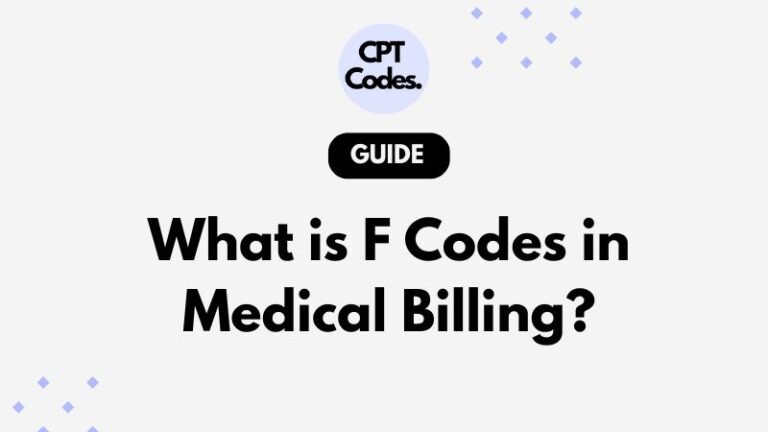In the world of medical billing, every service or procedure must be coded correctly to ensure accurate reimbursement. When it comes to vision and optical services, understanding F codes is crucial. These codes play an important role in identifying services related to eye exams, optical fittings, contact lenses, and vision therapy.
Whether you’re an optometrist, ophthalmologist, or medical billing specialist, mastering F codes helps reduce claim denials, speed up payments, and ensure compliance with insurance policies.
What Are F Codes in Medical Billing?
F codes are part of the ICD-10-CM (International Classification of Diseases, 10th Revision, Clinical Modification) system. They are primarily used to describe mental, behavioral, and neurodevelopmental disorders — typically ranging from F01–F99.
However, in the context of vision and optical billing, F codes can sometimes be referenced alongside eye-related diagnoses to describe behavioral or functional vision issues that may affect a patient’s eye care plan.
For example:
- F80.9 — Developmental disorder of speech and language, unspecified
- F88 — Other disorders of psychological development
- F07.81 — Postconcussional syndrome (often associated with vision therapy after brain injury)
These codes may appear alongside primary eye diagnosis codes (H codes) when billing for complex visual conditions.
Related Codes for Vision and Optical Services
While F codes identify psychological or functional components, most vision and optical procedures are coded with:
1. H Codes (Eye and Adnexa Diseases)
- H52.4 — Presbyopia
- H52.03 — Hypermetropia, bilateral
- H53.8 — Other visual disturbances
- H54.0 — Blindness, both eyes
These H codes are used to describe eye disorders and visual impairments.
2. CPT Codes (Procedures and Services)
CPT (Current Procedural Terminology) codes represent what the provider did.
Common optical CPT codes include:
- 92002 — Eye exam, new patient, intermediate
- 92014 — Eye exam, established patient, comprehensive
- 92015 — Refraction (determines prescription for glasses)
- 92310 — Fitting of contact lens, both eyes
- 92340–92353 — Spectacle fitting services
Together, F codes (for related conditions), H codes (for diagnosis), and CPT codes (for procedures) create a complete billing picture.
Why F Codes Matter in Billing
Although F codes are not the main codes for optical procedures, they are sometimes required to:
- Indicate underlying neurological or developmental conditions that affect visual performance
- Support medical necessity for vision therapy or rehabilitative eye care
- Ensure payer compliance when vision problems are related to trauma, brain injury, or psychological disorders
For instance, a patient with post-concussion syndrome (F07.81) may need visual rehabilitation therapy, coded under CPT 97110 (therapeutic exercises) or 97112 (neuromuscular reeducation).
Using the correct F code helps justify these services to the payer.
Example Billing Scenarios
Scenario 1: Vision Therapy for Post-Concussion
- Diagnosis: F07.81 (Postconcussional syndrome), H53.8 (Other visual disturbance)
- CPT Codes: 97112 (Neuromuscular reeducation), 92060 (Sensorimotor exam)
- Purpose: Link functional disorder (F code) with vision diagnosis for insurance justification.
Scenario 2: Developmental Vision Issues in Children
- Diagnosis: F88 (Other disorders of psychological development), H52.03 (Hypermetropia, bilateral)
- CPT Codes: 92002 (Eye exam), 92015 (Refraction)
- Purpose: Support billing for developmental visual problems often seen in pediatric patients.
Scenario 3: Behavioral Vision Therapy
- Diagnosis: F80.9 (Speech/language developmental disorder), H53.9 (Unspecified visual disturbance)
- CPT Codes: 97110 (Therapeutic exercises), 92065 (Orthoptic training)
- Purpose: Demonstrate link between behavioral and optical services.
Best Practices for Using F Codes in Vision Billing
- Always use the most specific code possible. Avoid unspecified F codes unless absolutely necessary.
- Pair F codes with relevant H codes to clearly describe the visual and behavioral aspects of care.
- Attach detailed documentation (exam notes, therapy plans, physician referrals) to support medical necessity.
- Verify payer requirements — some insurance carriers may require medical (not routine) billing when using F codes.
- Use correct modifiers (e.g., -25, -59) to distinguish multiple procedures on the same day.
- Stay updated — ICD-10 and CPT code lists are updated annually, so always verify accuracy before submission.
Common Mistakes to Avoid
- Using F codes alone without a supporting eye diagnosis
- Submitting outdated or invalid codes
- Missing documentation of the behavioral component
- Not linking therapy services to the correct primary diagnosis
Avoiding these errors ensures cleaner claims and faster reimbursements.
These resources are excellent for cross-checking your codes and staying compliant with the latest updates.
Conclusion
The F code in medical billing may not be the primary code for optical procedures, but it plays a crucial supporting role in vision and eye care claims — especially for developmental, neurological, or post-trauma cases.
By understanding how F codes, H codes, and CPT codes work together, medical billers and eye care providers can:
- Submit accurate claims
- Avoid denials
- Ensure fair reimbursement for complex vision services
Whether you’re billing for vision therapy, optical fittings, or comprehensive eye exams, using the right combination of codes is the key to efficient, compliant, and profitable billing.

